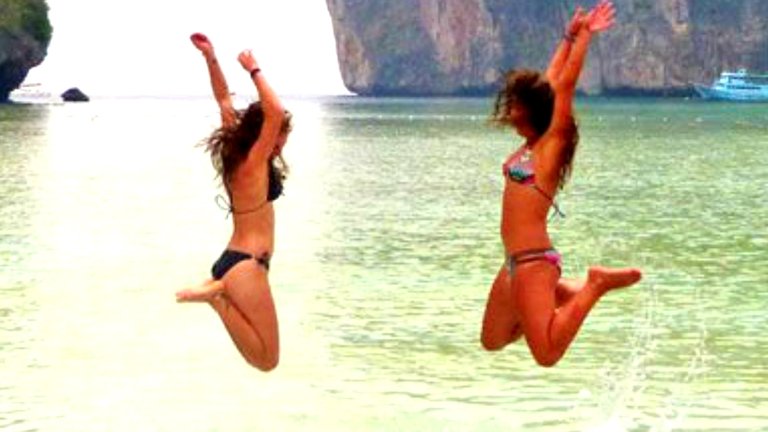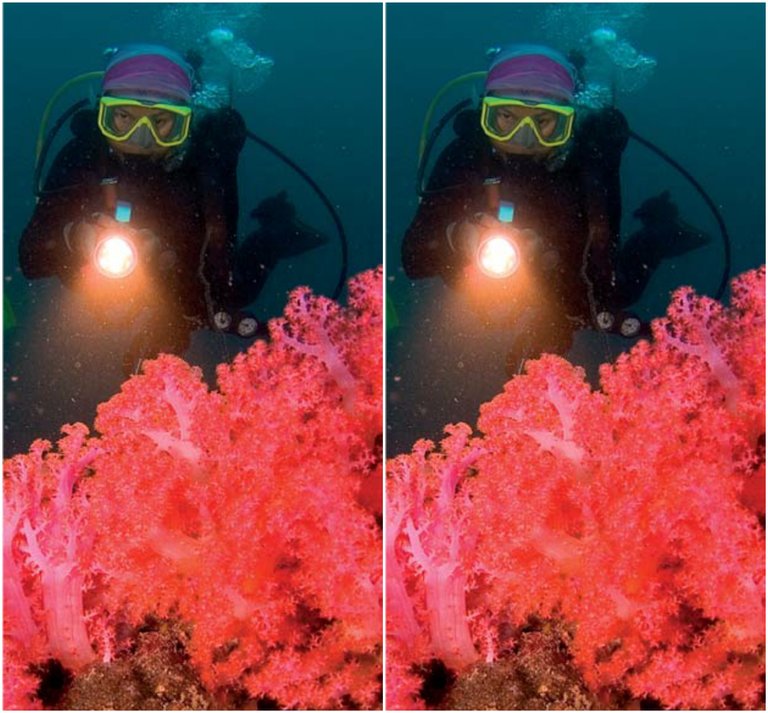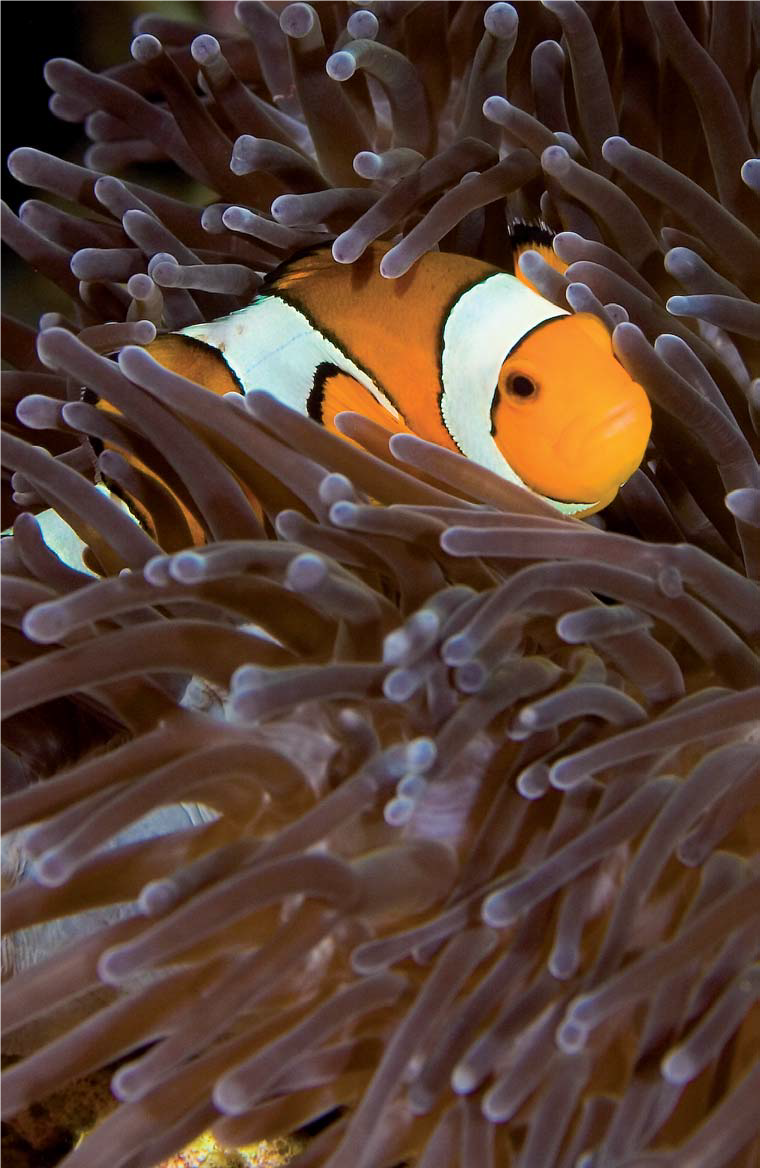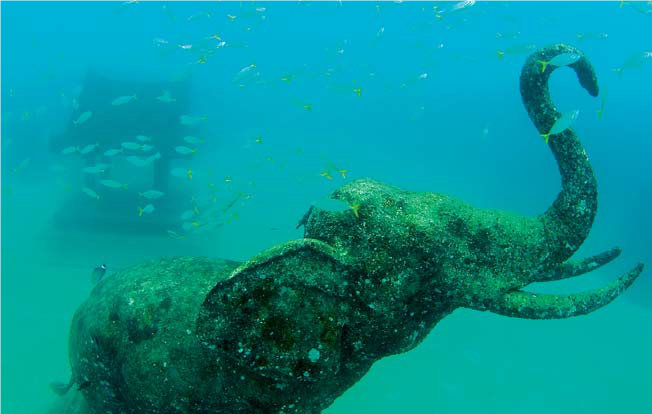
SOUTH TIP (RAY BAHN)
The south tip of Racha Noi is considered one of the better dive sites along this long island. If winds are blowing up from the south, captains may not attempt to make the haul down. Though if conditions are right this is a scenic spot with attractive coral gardens, boulders and pinnacles rising up around 40ft.
Manyhued soft corals appear anything from popsicle orange to ruby red, when using a light here to see their true colors.
Being the end of the island, currents can be strong as flows from both sides converge. Look here for schooling chevron barracuda, big rainbow runner schools and silvery jacks.
Down in the depths, look for the often-elusive leopard shark, along with big marbled stingrays; even whitetips have been seen resting when the currents are moving. This southern site also gets the occasional manta and a rare whale shark, but divers are more likely to see lionfish, scorpionfish, small schools of snappers and lots of fusiliers. Remember that the reeftop is at 40ft, so leave enough time for ascent and decompression.
.png)
NORTH TIP
Shallower than the south tip of Racha Noi, this site offers a lot of similar attractions with good soft coral growth and coral gardens nestled into the areas between the pinnacles and sloping terrain.
The North Tip is an advanced dive due to depth and occasional strong currents. While it may be a bit easier to avoid currents here than at South Tip, they can still be powerful, so be aware. A good location for pelagic life, chevron barracuda, dogtooth tuna and the occasional whitetip shark may make an appearance here.
As this site has been known to have down currents, it is best to follow your guide if the tide is changing to avoid areas where these prevail.

The 2004 Tsunami
December 26, 2004 is a day that continues to haunt the lives of many residents and visitors. One of the most devastating tsunamis ever recorded in Asia swept across the Indian Ocean, affecting beach and resort areas from Thailand to Madagascar and the African continent. Thousands of people died and many more were left homeless in Thailand and across the region.
For the most part, rebuilding is now going strong with resorts in Thailand cleaned up and operating back near their pre-disaster pace. The powerful wave did affect some popular reef areas and these sites have largely been closed in favor of some exciting, newlydiscovered sites.
While it may be hard to judge the long-term effects of the tsunami, nature appears to be adapting. Fish now have new habitat and the change in reef structure has opened up coastal areas for different invertebrate species and fish to move in.
Those who have not visited Thailand before would be hard-pressed to see much damage now, or discern any real change unless it was pointed out. Nature’s capacity to rebuild and alter the ocean floor is evident here and the reefs are rebounding well, making for a rewarding diving experience.
LUCY’S REEF
Divers of all levels will enjoy this site at Racha Yai, which features sloping reefs and a good mix of fish and other marine life.
Snorkelers who stay nearer the shore can actually go from this site to nearby Staghorn Reef. Care should be taken when finning though, as some coral patches grow right up to the shore and very near the surface, and can be easily damaged.
Orange-lined triggerfish, emperor angels and trumpetfish are among the fish that move around the coral outcrops and plating ledges that provide good habitat at Lucy’s Reef. They are joined by lots of smaller creatures, such as nudibranchs, crabs and sea stars. There is usually just enough current here to keep things active and as a result fish life in the water column can be busy at times. Keep an eye out for jacks and other reef lurkers.
The reef also has a decent collection of sea anemones, along with accompanying clownfish, Clark’s anemonefish and a few colorful percula. Sightings of the leaf-like cockatoo waspfish on the sea floor have also been made, along with some well-camouflaged frogfish. Ask your guide what types of marine life have been seen at this site recently and perhaps you’ll be lucky enough to get a glimpse of something odd and unusual.
This dive is sometimes done as a point A to B dive instead of returning to the buoy, with the boat picking divers up at the end point.

STAGHORN REEF
Another good snorkelers’ reef, this site has big staghorn coral patches and lots of chromis, with small, colorful fish moving over, around and in the dense patches of brittle staghorn. Drop in at the reef’s south end for the thickest growth areas.
Along with a slope of staghorn and other coral outcrops, there are white sandy patches that hold flounder, bluespot stingrays, garden eels deeper where the current flows and some hunting octopi. Mantis shrimp are also seen here.
The staghorn patches attract butterflyfish, including the longnose butterflyfish (called the ‘very longnose butterflyfish’ in Thailand) and occasional marauding groups of red-tailed butterflies. Other fish include the toothy titan triggerfish and emperor angels.
Fire corals are also found here, mixed in with the staghorns. Avoid contact with these as contact feels much like touching a lit cigarette.
Both this site and Lucy’s are protected most of the year from the southwest monsoon, as are most east coast sites in the Racha Islands.
BUNGALOW BAY
Located on the scenic west side of the island, this is a huge magnet for snorkelers, lunch-breakers and intro divers. Be warned, that means LOTS of boat traffic. Experienced divers probably won’t like dives inside the bay much, as it is noisy and the hard coral reefs aren’t overly thick with anything colorful.
Some disturbing anchor damage on the reefs is clearly visibly, caused by improperly thrown anchors that miss the sand patches and strike the coral. Always use a safety sausage around here when surfacing as well – you never know what’s coming or going on the surface.
The hard coral beds do hold puffers, crinoids, groupers, eels and lots of other reef fish. Look also for sea snakes winding their way through the reef looking for crustaceans. Divers usually dive along the rocky cliff face to the north; it gets deeper as one heads out to the bay’s mouth.
Sandy areas here can be productive, with odd creatures sometimes showing up. Reports of Pegasus sea moths, razorfish and harlequin ghost pipefish (which look like a blade of sea grass), have all been sighted. Pipefish may just be hanging in the sand or perhaps hovering next to a palm frond, mimicking debris. Nudibranch expert Mark Strickland reports that some species seldom seen else where have been identified here.

AO SIAM
This is a real fun dive with lots of divers’ ‘toys’ to play with. The site was developed recently with artificial reef structures designed to attract fish and give corals some substrate for growth. Looking like a boxy, wild, underwater jungle gym, small hard corals are already beginning to sprout here, with small puffers, rays and lionfish making them home.
There are two buoys in the bay leading down to a rather unremarkable sandy sea floor at roughly 60ft. Aside from the artificial reef structures, the real bonus here is a life-sized temple entrance and two full-sized Thai elephants; one standing high on its back legs. These make great photographic props as divers can swim over and under the elephants and through the temple doors.
These sculptures also act as artificial reefs, with butterflyfish, schooling fusiliers and spotfin lionfish all using these pachyderms and holy gates as refuge. When you tire of playing here, or run low on camera space, head inland toward the shallower reaches of this fun little bay. Shallower staghorn reefs in the 20 to 30ft range provide shelter for chromis and mantis shrimp. Frogfish are also sometimes seen here.

THE ‘NOI’ DIVES
Just two minutes away from the Sea Fun Divers dive shops at the beachside hotels are the Kata Noi Beach and Karon Noi reefs. Sea Fun has developed these ‘house reefs’ for night diving and training, but they are of particular interest for macro photographers as well.
Depths reach just 30ft, allowing for nice, long dives with plenty of looking around, and currents are almost nonexistent, making an ideal place for training dives.
Kata and Karon beaches are used during PADI dive courses and for a ‘Discover Scuba Diving’ experience, and are good for advanced training, in particular for navigation dives and night dives. Visibility isn’t always great but is generally around 30ft to 50ft, and the reef has a good array of hard corals and tree worms.
Fish life is also good with schools of snapper always present, along with prowling and hiding lionfish, scorpionfish and puffers. For fish watchers and photographers, the real plus is the macro life that can be encountered by looking in the right habitats, including such oddities as seahorses, ghost pipefish, razor fish, flatheads and ribbon eels. Ribbon eels aren’t too common in many places in Thailand, so those alone are a real plus.
As the guides are here daily to teach, they can help with finding good critter life.
Related Post :
@OriginalWorks
The @OriginalWorks bot has determined this post by @itpro to be original material and upvoted it!
To call @OriginalWorks, simply reply to any post with @originalworks or !originalworks in your message!
Resteemed by @resteembot! Good Luck!
The resteem was payed by @greetbot
Curious?
The @resteembot's introduction post
Get more from @resteembot with the #resteembotsentme initiative
Check out the great posts I already resteemed.
Hi. I am @greetbot - a bot that uses AI to look for newbies who write good content.

I found your post and decided to help you get noticed.
I will pay a resteeming service to resteem your post,
and I'll give you my stamp of automatic approval!